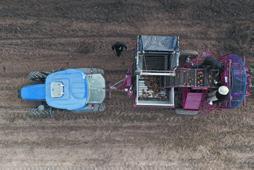CIIE VOLUNTEERS

Volunteers of the Third China International Import Expo (CIIE) take their oath at the National Exhibition and Convention Center in Shanghai on October 18.
Over 4,800 people were sworn in as volunteers and went on duty that day.

Greening Expo
Visitors take photos at the Shanghai exhibition area of the Fourth China Greening Exposition in Qiannan Buyi and Miao Autonomous Prefecture in Guizhou Province, southwest China, on October 18. The expo will end on November 18.
Vaccine Progress
About 60,000 volunteers have been given novel coronavirus disease(COVID-19) vaccines developed in China as part of phase-3 clinical trials, with no severe side effects reported, a Chinese official said on October 20.
Four potential vaccines have entered international phase-3 clinical trials so far, according to Tian Baoguo, an official with the Ministry of Science and Technology, at a news conference in Beijing. All trials are progressing well, he said.
According to Tian, the most common adverse reactions in the phase-3 trials are mild pain and swelling at the injection site, followed by fever.
Two inactivated vaccines developed by China National Biotec Group (CNBG), which is affiliated to Sinopharm, and the Wuhan Institute of Biological Products have started phase-3 clinical trials in 10 countries, with more than 50,000 volunteers taking part, Sinopharm Chair Liu Jingzhen said.
Sinovac Biotech, another vaccine developer, said its partners in Brazil, Indonesia and Turkey have established monitoring systems for adverse reactions in accordance with internationally accepted standards. So far, no severe adverse reactions have been reported.
High-Speed Train
Chinese train maker CRRC Changchun Railway Vehicles on October 21 rolled out a new type of high-speed train which can run on different rail systems.
The train, with a standard speed of 400 km per hour, has been developed to cope with different rail systems on international routes, making international rail travel more convenient.
The company said the train can operate in temperatures between minus 50 degrees and 50 degrees Celsius, and also under different traction power supply systems and meet transportation standards of different countries.
The company is ready to take orders for customized high-speed trains and train products.
There are currently four main railway track standards around the world. When ordinary trains run between countries with different gauges, they need to replace their bogies, which takes time and effort.
As the new CRRC train is equipped with gauge-changing bogies, it can change its rail mode during cross-border travel, greatly improving the efficiency of travel across rail systems.
Going Digital
Yiwu China Commodities City, the worlds largest small commodity market, launched an online platform on October 21, a key step toward digital transformation.
The www.chinagoods.com website relies on resources of 75,000 physical stores in the Yiwu market and serves 2 million micro, small and medium-sized enterprises in the upstream industrial chain.
Yiwu, a city in Zhejiang Province in east China, sells commodities to about 200 countries and regions every year. It has been seeking new opportunities through digital transformation amid the COVID-19 pandemic.
In the January-September period, Yiwu saw its exports grow 5.1 percent year on year. It handled 4.73 billion parcels, ranking second nationwide.
Employment Report
Xinjiang Uygur Autonomous Region in northwest China issued a report on the employment of ethnic groups in the region on October 20.
The report, released by the Xinjiang Development Research Center, concludes that governments at all levels as well as enterprises in Xinjiang and other provincial level administrative regions have helped people of different ethnic minority groups find jobs and safeguarded their basic rights such as work and development rights.
In recent years, local governments in Xinjiang have been promoting job opportunities for workers of ethnic groups both within and outside the region, and have formulated favorable policies and regulations related to employment.
Xinjiang has invested heavily in vocational training over the years. Statistics indicated that the region arranged skill training for about 6.96 million people from 2014 to 2019.
Over the past five years, the region has helped nurture 379,400 new entrepreneurs, who have given jobs to 827,400 people.
At the end of 2019, the number of people insured for basic endowment, unemployment and workrelated injuries in Xinjiang reached 18.91 million, with a coverage rate of more than 90 percent.

Machine Wins Potato Race
A new potato harvesting machine on display in Fengbu, a village in Guyuan, Ningxia Hui Autonomous Region in northwest China, on October 20. The new machine can harvest 80 tons of potato a day while a person can harvest only 1 ton.
War Exhibition
An exhibition commemorating the 70th anniversary of the Chinese Peoples Volunteers assistance in the War to Resist U.S. Aggression and Aid Korea (1950-53) opened at the Military Museum of the Chinese Peoples Revolution in Beijing on October 19.
Wang Huning, a senior Communist Party of China official, called it a war for justice that safeguarded peace and resisted aggression.
On October 19, 1950, on the Democratic Peoples Republic of Korea (DPRK)s call for help, Chinese volunteers crossed the Yalu River on the China-DPRK border to assist in the war till a truce was signed in 1953. A total of 2.9 million volunteers fought in the war and over 197,600 of them died.
The exhibition features photographs, weapons used during the war, artwork and other memorabilia. It will run through the year till the end of February 2021.
Port Power
The island province of Hainan in south China has started construction on a shore power project at the Port of Yangpu to reduce pollution by ships berthed at the port, according to a report by Xinhua News Agency on October 19.
Contracted by the Hainan branch of State Power Investment Corp. (SPIC) with an investment of 97.2 million yuan ($14.5 million), the project covers 15 berths at the port and has a maximum power supply capacity of 16.28 megavolt ampere.
The main part of the project is scheduled for completion by the end of 2020, according to Sun Qunli, General Manager of SPIC Hainan, who said ships docking at the port will be able to use shore power directly instead of relying on their own oil-fired power generation.
The project will reduce nitrogen oxide, sulfur oxide and suspended solid emissions by over 95 percent, or 1,168 tons a year, according to Sun.

Preparing for Olympics
A Chinese and a French ice maker lay a racing track at the National Snowmobile and Sled Center built for the Olympic Winter Games 2022 in Yanqing, a suburban district of Beijing, on October 18. Eight foreign and 20 domestic ice making professionals have participated in the work since October 9.
Drug Users
Around 227,000 impoverished people with a history of drug abuse have shaken off poverty since combined efforts for narcotics control and poverty alleviation were stepped up in 2018.
The situation in 34 of the listed regions where drug abuse used to be a serious problem has improved, leading to their removal from the priority list for narcotics control.
These figures are from a national conference held in Liangshan, a prefecture in Sichuan Province in southwest China, on October 20.
The National Narcotics Control Commission said further efforts should be made to tackle drug problems and ensure the regions still on the list are removed at the earliest.
Du Hangwei, Vice Minister of Public Security and deputy head of the commission, said efforts are on to ensure that all the remaining impoverished people with a history of drug abuse are free of narcotics use and out of poverty by the end of the year.
Space Launches
Aerospace experts outlined greater development of the commercial space industry at the Sixth China(International) Commercial Aerospace Forum held in Wuhan, Hubei Province in central China, on October 19.
During the 14th Five-Year Plan(2021-25) period, China will continue building space infrastructure, enhance the capability of commercial space systems, and integrate them into major national development strategies, Fu Zhimin, chief engineer of the China Aerospace Science and Industry Corp., said.
Development of the commercial space sector will also drive the highquality development of strategic emerging sectors such as the digital economy, intelligent manufacturing and new materials, Fu added.
According to the forum, China will continue developing Kuaizhou rockets, which are low-cost solid-fuel space vehicles with high reliability and a short preparation period. The number of annual launch missions of Kuaizhou rockets will be doubled by 2023 and China will have developed world-class solid propulsion technology by 2025.
China will enhance international cooperation and expand the global resource allocation capacity of commercial space technologies and products. It will provide more commercial space launch services to international users, especially participating countries of the Belt and Road Initiative, Fu said.

Virtual Experience
Visitors view ancient Chinese architecture with virtual reality (VR) glasses during the 2020 World Conference on VR Industry in Nanchang, Jiangxi Province in east China, on October 19. Around 100 participants from 18 countries and regions discussed the VR industry ecosystem and its application in entertainment, tourism, healthcare and other fields in person or via video link.
Fintech Center
A national fintech certification center has been established in Chongqing Municipality in southwest China, Xinhua News Agency reported on October 18.
Fintech refers to technologyenabled innovation in financial services.
The establishment of the center marked a significant step in the implementation of the Fintech Development Plan (2019-21), and was a measure to improve the regulatory framework for fintech, said Fan Yifei, Deputy Governor of the Peoples Bank of China, the central bank.
The center should aim at national strategic needs including innovation-driven development and the construction of the ChengduChongqing economic circle, and build up its core competence by relying upon the unified national certification system for fintech products, he said. It is expected to develop into a first-class certification authority, serve as a “gatekeeper” for integrity, innovation, safety and compliance in fintech development, and become the backbone in the joint governance system for fintech in China, according to Fan.
Tesla Exports
U.S. electric carmaker Tesla announced on October 19 that it will export the made-in-China Model 3 to Europe, marking another important milestone for its Shanghai Gigafactory.
The first batch of exported sedans left Shanghai on October 27 and will arrive at the Port of Zeebrugge in Belgium at the end of November before being sold in European countries.
“Relying on Chinas industrial chain advantages and advanced manufacturing level, the global competitiveness of the China-made Model 3 is robust,” Song Gang, Manufacturing and Operation Director of Tesla Shanghai Gigafactory, said.
According to Tesla, it has overcome impacts of the novel coronavirus disease epidemic as its production and sales activities have recovered with the help of governments at all levels.
After the production capacity reaches the first-stage target, Tesla can meet needs of Chinese consumers while providing high-quality products to European consumers, Song said.
SOE Performance
Centrally administered stateowned enterprises (SOEs) reported both profit and revenue growth in the third quarter (Q3), the StateOwned Assets Supervision and Administration Commission of the State Council (SASAC) said at a press conference on October 20.
Revenue of these companies rose 1.5 percent year on year to 7.8 trillion yuan ($1.17 trillion) in Q3.Their net profit totaled 474.8 billion yuan ($71.1 billion), up 34.5 percent from the previous year, SASAC data showed.
In September alone, their revenue hit 2.8 trillion yuan ($419 billion), a 4.3-percent expansion from a year ago and the highest monthly growth this year.
The figure for the first three quarters edged down 4.6 percent from a year earlier to 21.1 trillion yuan ($3.1 trillion), narrowing by 1.2 percentage points compared with the contraction in the first eight months.
Meanwhile, the net profit of centrally administered SOEs in the first three quarters dropped 13.6 percent year on year to 913.35 billion yuan($136 billion), as against a decline of 24.9 percent in the first eight months, according to SASAC.
“The vast majority of enterprises basically reversed the unfavorable situation in the first half of the year and returned to the normal track of business development,” SASAC spokesperson Peng Huagang said.
In the first three quarters, the profit margin of centrally administered SOEs stood above 7 percent and reached 9.5 percent in September, the highest in a decade, he said.

Profitable Business
A worker feeds Suffolk sheep at a farm in Manas County, Xinjiang Uygur Autonomous Region in northwest China, on October 19. The countys high-quality mutton products are sold in metropolises including Beijing and Shanghai via e-commerce platforms, generating a stable income for local residents.
Logistics Cooperation
Alibabas Cainiao Smart Logistics Network Ltd., one of Chinas courier giants, signed a cooperation agreement with American freight transport airline Atlas Air Worldwide Holdings on October 20.
According to the agreement, there will be three Atlas Air charter flights every week linking China with Brazil and Chile, reducing the overall shipping time from a week to three days on average.
As the cross-border trade between China and South America continues to expand, Cainiaos parcel volume to regional countries exceeded 8 million in Q3, double the number in the previous quarter.
“Our partnership with Atlas Air will help us establish an efficient, reliable network to South America and other worldwide destinations by significantly reducing airfreight delivery time for the merchants we support,” said William Xiong, Cainiaos chief strategist and general manager of export logistics.
Cainiao is expected to operate about 1,300 charter flights by the end of 2020. The global operating networks will enable it to enhance its logistics capabilities and offer customers faster deliveries globally, according to company sources.
John Dietrich, President and CEO of Atlas Air Worldwide, said he is “excited to support Cainiao and Alibabas fast-growing e-commerce business and its global expansion in South America.”

Ride to Fortune
An exhibition room of Tangshan Jinhengtong Group in Lutai Economic Development Zone in Tangshan, Hebei Province in north China, on October 14. Bicycle components produced by more than 40 companies in the zone have gained a footing in the domestic and global market, with their combined annual output value reaching 5 billion yuan ($745 million).
Digital Growth
Shandong Province in east China will ramp up efforts to bring its digital economy to a world-class level by 2030, according to a press briefing held in its capital city Jinan on October 19.
The province aims to foster innovative enterprises and industrial clusters in Jinan and build it into a national leading technology center in computing power, arithmetic and algorithms based on its advantages in computing power infrastructure.
Jinan has attracted 56.6 billion yuan ($8.4 billion) in investment, covering 68 projects in 12 categories to expand its digital industry, according to official statistics.
By 2022, the city is expected to see the output value of the digital sector surpassing 530 billion yuan($79 billion), accounting for over 47 percent of its gross domestic product (GDP). It will be supported by technological innovation in servers, supercomputing, software, and quantum information, artificial intelligence (AI) and blockchain technologies. It is expected to be worth more than 1 trillion yuan ($149 billion). The digital economy will account for over 60 percent of the total GDP by 2030, a plan said.
In 2019, the digital economy in Jinan accounted for about 39 percent of its GDP. Currently, more than half of Chinas AI computing power comes from Jinan, Ji Peide, Director of the Jinan Municipal Bureau of Industry and Information Technology, said.

